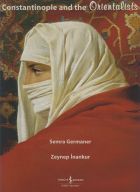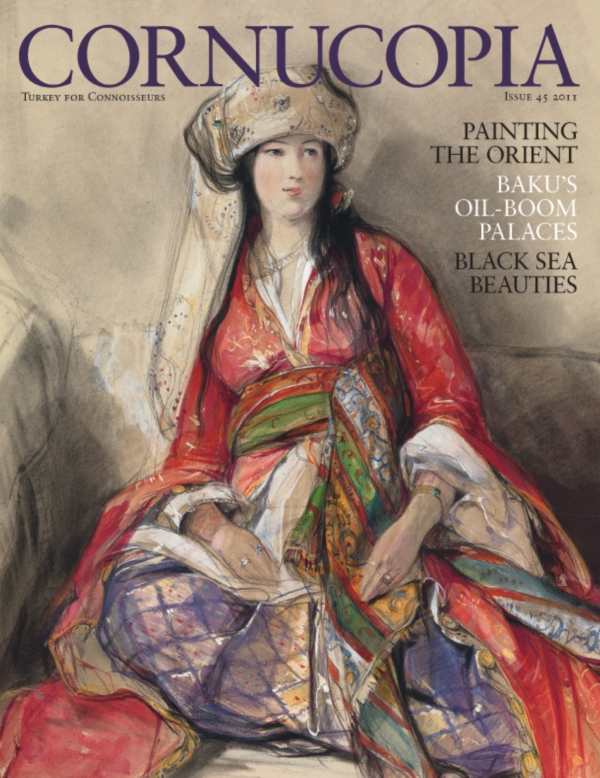Buy or gift a stand-alone digital subscription and get unlimited access to dozens of back issues for just £18.99 / $18.99 a year.
Please register at www.exacteditions.com/digital/cornucopia with your subscriber account number or contact subscriptions@cornucopia.net
Buy a digital subscription Go to the Digital EditionAard Streefland tells the story of Marius Bauer
One of the stars of Orientalism, the summer exhibition at Istanbul’s Sakıp Sabancı Museum (SSM), is Marius Bauer (1867–1932), the Netherlands’ best-known Orientalist. In the late 19th century, while other Dutch artists were preoccupied with the streets and landscapes of their home country, Bauer found his own niche by heading eastwards. During his life he would make several trips to Istanbul, recording the everyday life of the city in lively sketches and atmospheric pastel drawings.
Marius Bauer was born in The Hague on January 25, 1867, the youngest of six children. His father owned a painting-and-decorating shop. From an early age, Marius showed a passion for illustration, and at 13 he was admitted to the city’s Royal Academy of Art. In his late teens he was encouraged to join the Dutch Etching Club by the painter and writer Philippe Zilcken, who kindled his enthusiasm for the East by telling him about his travels in Algeria.
At the age of 21, Bauer met the art dealers EJ van Wisselingh, who recognised his talent and financed his first trip to Turkey. He set off in early October 1888, taking a train to Marseille and then travelling by boat, via Smyrna, to Istanbul. He stayed there until the end of the year, overwhelmed by his impressions of the city, which prompted him to dash off five sketchbooks of drawings and to produce around 100 larger pastels.
The drawings would later inspire a series of etchings, which in turn would produce some very lucrative prints for Van Wisselingh. An exhibition devoted to his etchings opens in May this year in Mardin. Bauer’s experiences in Istanbul are recorded in correspondence with family and friends, which he often illustrated. In one missive to his sister Fré, he wrote: “My letter has now become riddled with little drawings rather than words.” A sociable and adventurous man, he noted: “Sometimes I walk through Istanbul with a cigarette and if anyone sees that I don’t have a light they will offer one. One time a boy even came out of his shop to be of help with some coal.”
He returned to Istanbul in 1892, filling four more sketchbooks, and again in 1896, by which time he was writing for De Kroniek, the highly respected Dutch weekly magazine (to which he also contributed 52 cartoons, under the name Rusticus). He regaled its readers with details of his visit to a dervish monastery, and of an excursion to the Sweet Waters of Asia, showing that he could conjure colourful pictures with words as well as with his art. On the river that gives the Sweet Waters its name, he observed “many little boats with veiled women who take in the scenery with childlike pleasure”. At the water’s edge, “next to an elegant palace, one finds a large field surrounded by beautiful trees with, in front, a group of ancient and magnificent plane trees. These provide shade for a broad terrace with a fountain, beautifully constructed out of white marble and decorated with ornaments and calligraphy in gold.”
Bauer’s writing didn’t always please: he had outraged many of De Kroniek’s liberal-minded readers earlier that year, when he travelled to Moscow and filed a somewhat overenthusiastic account of the crowning of Tsar Nicholas II.
Bauer would return again to Istanbul – in 1899, on his way to Syria and Palestine; in 1904, when he combined Istanbul with Bursa, Izmir and Egypt; and in 1911, again taking in Syria and Palestine. By then he was also enchanted by India, where he had spent four months in 1897–98. His later, large-scale etchings of the Ganges and the great mosque in Delhi were to make him more widely known, his frequent use of chiaroscuro inviting comparisons with Rembrandt.
In 1902, Bauer married Jo Stumpff, the daughter of Amsterdam’s leading orchestral conductor, who became a member of a group of female artists known as the Amsterdamse Joffers. Together the Bauers went on to visit Egypt, Algeria, Morocco and India, making one last long trip to the East Indies in 1931. A year later, Marius died in Amsterdam at the age of 65.
During his lifetime, his passion for Istanbul was expressed in architecture as well as art: in 1901 he commissioned his architect brother Willem to build him a residence in the smart Dutch village of Aerdenhout, which he named the Villa Stamboel.
a.a.streefland@gmail.com
This year [2013] Marius Bauer’s work is included in 1001 Faces of Orientalism at the Sakıp Sabancı Museum (from April 25) – a tribute to Edward Said’s book Orientalism, published 35 years ago. His etchings are at the SSM’s Mardin City Museum, May 15–Sept 29. muze.sabanciuniv.edu Schiedam’s Stedelijk Museum held a major Bauer exhibition for the 2012 celebrations of the 400th anniversary of Dutch–Turkish relations. stedelijkmuseumschiedam.nl/
Balaklava, Sevastopol, Inkerman, the Valley of Death – in Britain, where the savage toll was so acutely felt, these names still have the power to arouse pride and fury. Algernon Percy travelled to Crimea to visit the evocative battlefields
From the Danube to the Caucasus, conflict raged. The Ottomans were fighting for their territories and their lives, but the full story of their courage is only now being told, says the military historian Mesut Uyar
The war of 1853–56 was a calamitous clash of imperial ambitions. Turkey sustained heavy losses, but without them she might have ceased to exist. David Barchard puts the conflict in context
With its healing brine baths and golden beaches, its wealth and variety of architecture, and its layers-deep history, this resort offers something for everyone – from hedonist to hypochondriac
Yevpatoria in Crimea was the home the young Anna Akhmatova, an icon of Russian literature, who fell foul of Stalin
Like many writers, Chekhov made his way to Crimea to nurse his TB in a milder climate. His two houses, now museums, became magnets for artists. One he left to his sister, the other to his wife.
Philip Mansel on the future Edward VII’s Ottoman expedition
By any standard, Hüsamettin Koçan’s mountain-top Baksı Museum, in the northeastern Anatolian village where he was born, deserves a place among the world’s top ten remote museums.
This silver goblet was one of more than 600 medieval treasures from Central Asia crowding Bonhams’ elegant rooms in Edinburgh for six days in January.
Mulberries come in an array of hues: black, white, pink, purple; some enticingly sweet, others astringent and healing. As Berrin Torolsan can testify, having grown up with them in her Istanbul garden, all are adored – by man, mallard and pine marten alike. Here she traces the history of this lucious fruit
Thomas Whittemore, the American scholar and philanthropist, was instrumental in restoring the Byzantine treasures of Ayasofya. Robert S Nelson delves into his enigmatic life
The V&A’s Tim Stanley eyes up the Louvre’s astonishing new Islamic offering
From the towers of Tatary to the tombs of Scythian kings, from clifftop citadels to an underground castle, from Balaklava to the beaches of the Tsarist Riviera, Crimea is a land to fall in love with, waiting to be enjoyed, not destroyed
As the Sadberk Hanım Museum celebrates the art of embroidery, Min Hogg marvels at the motifs of palaces, fruit and flowers, sea and cityscape, wrought stitch by stitch, to adorn every Ottoman home
The Crimean khans founded their capital in the fertile foothills of the Crimean Mountains in the 15th century. This was the nucleaus of the land known as Cim Tartary. The garden palace of Bahçesaray is a glorious reminder of the khans’ 350-year reign
Dramatic and picturesque, Crimea’s southern coast became a resort for doomed royalty and a refuge for ailing literati
Two ports – Sevastopol and Yevpatoria – rule Crimea’s flat west coast. One was built for war, the other for recreation. Both played a part in the Crimean War
Geonese merchants, a millionaire painter and a symbolist poet brought fortune and fame to the eastern stretches of Crimea’s south coast and its fertile hinterland



Cornucopia works in partnership with the digital publishing platform Exact Editions to offer individual and institutional subscribers unlimited access to a searchable archive of fascinating back issues and every newly published issue. The digital edition of Cornucopia is available cross-platform on web, iOS and Android and offers a comprehensive search function, allowing the title’s cultural content to be delved into at the touch of a button.
Digital Subscription: £18.99 / $18.99 (1 year)
Subscribe now